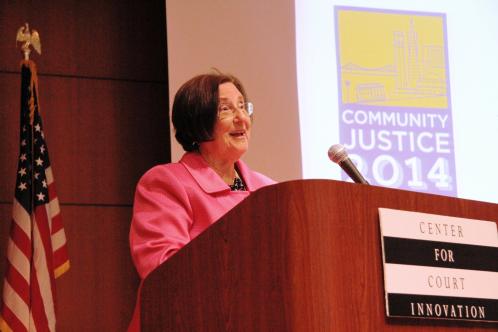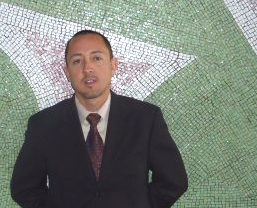Judge Braden C. Woods of the San Francisco Community Justice Center discusses the practical implications
of expanding the court’s caseload to include low-level felonies, and he reflects on his first year on the job. (April
2014)
JUDGE BRADEN WOODS: This is a great assignment
because every day I’m enthusiastic about going to work and trying to help somebody get out of the system instead
of just recycling themselves at the hall of justice and at our county jail.
ROBERT V. WOLF: Hi,
I’m Rob Wolf, director of communications at the Center for Court Innovation, and I am in San Francisco today
at Community Justice 2014. I am lucky to be speaking right now with Braden C. Woods, who is the presiding judge of
the San Francisco Community Justice Center.
JUDGE WOODS: Thank you for having me, it’s great
to be here, great to be at the Summit.
WOLF: I thought it would be interesting to talk to you
about both the five year evolution of the San Francisco Community Justice Center and also your more recent experience—you’ve
been the presiding judge for the last year. Let’s talk about how the San Francisco Community Justice Center
has evolved from a court that initially accepted just misdemeanors, to one that now is dealing with low level felonies.
Why the change and what does it mean?
JUDGE WOODS: We’ve learned, stolen from other programs
that are doing a great job, and we felt comfortable enough after doing just misdemeanor cases for approximately two
and a half, almost three years, that we could expand the program when there are so many other people who are catching
felony cases, low level felony cases, that need the same support, services, that we’ve been giving the folks
on misdemeanors. And our program was established with our partners from the Department of Public Health. They gave
us more resources to expand the program, more case management resources, and with that added help, we were able to
start taking on more cases, more serious cases of folks who are now committing felonies.
WOLF:
And what kinds of felonies?
JUDGE WOODS: So we take pretty much all low level felonies here in
California—that would be car break-ins, commercial burglaries, car theft, all drug cases, low level drug cases, mostly
folks who are selling their own legal prescription to get money to buy other drugs, multiple priors can make a theft
case a felony, so we’ll take them into our program.
WOLF: And are you applying the same strategies
and tools, and principles of punishment and help, and having people do community service while also linking them
to services? Or are there additional features or strategies that come with working with low level felony offenders?
JUDGE WOODS: Same strategies on its most basic level. We’re dealing with a harder population. Some
of these folks have mental health issues, even more long-term drug addiction issues, so the program is the same,
but folks are in the program much longer than on some of the misdemeanor cases. We don’t transition them to
our community service portion until we’re really on solid footing in terms of their drug or alcohol addiction,
abuse issues. So the programming in terms of classes and meetings is much longer before we feel confident and comfortable
to then transition them to the prosocial community support, community give back portion of it.
WOLF:
And someone asked a question when you were on a panel this morning about—when you were on the panel that focused
on the next generation of community courts. And someone asked, how did you work with the community to prepare them
for the fact that you’re going from misdemeanors, that maybe people felt less threatened by, or less concerned
about how they were treated, or could be enthusiastic about giving them services, and maybe some people were less
enthusiastic about offering the help to people who had committed more serious crimes.
JUDGE WOODS:
Communication is the key and so we did give the community a heads up that we were going to maybe go down this path,
and we sought their input. Some folks were like no, forget about it, felons have to go to jail. But a lot of folks
were on board, wanted to give it a try because those are the felons, these low level felony folks, who are hurting
themselves and hurting community, and not individuals. And they were open to the idea of getting these people into
services to help break the cycle. So based upon the charges that we were gonna do, and handle, a lot of folks were
enthusiastic about it because those are the people—some of these lower level felony people, who were affecting the
community directly, and who they were seeing on a daily basis, or maybe a weekly basis. They see the police arrest
them, the person would come back a week later and they’d go to their police captain, or go to the district attorney’s
office and go, what happened? The person plead guilty, he accepted responsibility. He’s on probation and he
did his time. And they’re like, well he’s doing the same thing. And so by shifting them to our community
justice center and getting them into treatment and services, we’re trying to break that cycle. And so when community
members see the person and they’re not up to no good, they’re anecdotally like oh, it’s working, as
opposed to just the recycle of jail, out, jail, out.
WOLF: And so let’s talk about your evolution
as a jurist. What was it like for you beginning to reside over this court? What have you learned over this past year?
JUDGE WOODS: It’s been a great year. I’ve actually been a judge just for a year, also. This was
my first assignment as a judge and we sometimes rotate every year to new assignment, and when the presiding judge
asked if I wanted to stay, enthusiastically I was like, very much so. I have unfinished business, as they say. But
I was a local prosecutor here, in San Francisco, I live here in the city. I’ve lived here for 15 years and I
got to see the difference between hard core criminals who are hurting other people, and low level criminals who are
hurting themselves, and see sort of the spectrum. And this is a great assignment because every day I’m enthusiastic
about going to work and trying to help somebody get out of the system instead of just recycling themselves at the
hall of justice and at our county jail. So the evolution, for me, has been a good one to see it from a different
perspective, and I hope to continue to expand our current program, as well as some other programs here in San Francisco.
WOLF: And what do you think are the biggest challenges to evolving the criminal justice system so that it
incorporates evidence-based strategies, procedural justice, these things that we know work, but perhaps the system,
for lack of funds or lack of training, or just habit, is maybe slow to incorporate?
JUDGE WOODS:
The biggest challenge is trying to get everybody to the table. We’re slowly but surely getting there in San
Francisco. We’re sort of there in terms of district attorney, public defender, the police chief, the mayor’s
office, which funds, obviously, a lot of the programs that we use here in San Francisco and the non-profits Trying
to just get everybody in the same boat and rowing in the same direction. So we’re good with that. The biggest
challenge I see with us, I think it’s nationwide, is dual-diagnosis, the mental health issue. We’ve spent
a lot of money and time and best practices trying to figure out drug and alcohol issues in programming and best practices,
and we do a good job of that, but trying to find this other niche, folks with mental health issues, as well as drug
and alcohol, is something that I find to be a challenge, just in terms of finding programs, and enough beds, and
enough people who have training in both. One size does not fit all when it comes to mental health and drug and alcohol
issues. So that’s where the challenge of melding those two and working together.
WOLF: What
do you think is going to happen if and when you move on to a different role as a judge? Are you going to take some
of these strategies or things that you’ve learned with you into new settings? And what if it’s a setting
that isn’t—if it’s not a community justice center that doesn’t immediately have the tools to assess,
or to link to services, or send someone to community service? What would you do?
JUDGE WOODS:
No offense to them, I’d educate some of my other public judges at the hall of justice, in terms of you can get more
bang for your buck with a huge segment of population that does come through the hall of justice into the criminal
system. So just exposing them to what I’ve been doing for the past year, it’ll be at least two years before
I see them again, and some of the other judges who have come before me, have run the community justice center, and
just giving our knowledge to our other brethren who have only been at the hall of justice, or only been at the civic
courthouse, and just let them know that there are alternatives and better ways of doing things. Even though I’m one
of the junior members on the bench, I think I can educate some of my brothers and sisters on the bench.
WOLF: Judge Woods, thank you so much. I really appreciate your sharing your insights and your experience
with me. It’s been very interesting.
JUDGE WOODS: Rob, thank you very much. I really appreciate
it.
WOLF: I’ve been speaking with Braden C. Woods, who is the presiding judge of the San
Francisco Community Justice Center, and we are both here today at Community Justice 2014, it’s being held, actually,
at the office of the California Courts, here in San Francisco. I’m Rob Wolf, director of communications at the
Center for Court Innovation. To find out more about the Center for Court Innovation, visit our website at www.courtinnovation.org.
You can also listen to our podcasts there, and you can also find us on iTunes. Thanks for listening.
Podcast: Play in new window | Download


